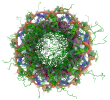SAS:Scattering profile?
SAS data used in this integrative model was obtained from 5 deposited SASBDB entry (entries). Scattering profile data from solutions of biological macromolecules are presented as both log I(q) vs q and log I(q) vs log (q) based on SAS validation task force (SASvtf) recommendations. I(q) is the intensity (in arbitrary units) and q is the modulus of the scattering vector.
Key experimental estimates?
Molecular weight (MW) estimates from experiments and analysis: true molecular weight can be compared to the Porod estimate from scattering profiles.
| SASDB ID | Chemical composition MW | Standard MW | Porod Volume/MW |
|---|---|---|---|
|
SASDBV9
|
12.6 kDa
|
12.2 kDa
|
Not available
|
|
SASDBW9
|
24.1 kDa
|
25.2 kDa
|
Not available
|
|
SASDBZ9
|
49.4 kDa
|
48.3 kDa
|
Not available
|
|
SASDBX9
|
12.5 kDa
|
14.7 kDa
|
Not available
|
|
SASDBY9
|
25.9 kDa
|
25.2 kDa
|
Not available
|
Volume estimates from experiments and analysis: estimated volume can be compared to Porod volume obtained from scattering profiles.
| SASDB ID | Estimated Volume | Porod Volume | Specific Volume | Sample Contrast | Sample Concentration |
|---|---|---|---|---|---|
|
SASDBV9
|
Not available
|
17.94 nm³
|
Not available
|
Not available
|
Not available
|
|
SASDBW9
|
Not available
|
22.50 nm³
|
Not available
|
Not available
|
Not available
|
|
SASDBZ9
|
Not available
|
66.59 nm³
|
Not available
|
Not available
|
Not available
|
|
SASDBX9
|
Not available
|
56.68 nm³
|
Not available
|
Not available
|
Not available
|
|
SASDBY9
|
Not available
|
27.97 nm³
|
Not available
|
Not available
|
Not available
|
Flexibility analysis ?
In a Porod-Debye plot, a clear plateau is observed for globular (partial or fully folded) domains, whereas, fully unfolded domains are devoid of any discernable plateau. For details, refer to Figure 5 in Rambo and Tainer, 2011. In a Kratky plot, a parabolic shape is observed for globular (partial or fully folded) domains and a hyperbolic shape is observed for fully unfolded domains.
Flexibility analysis for SASDBV9.
Flexibility analysis for SASDBW9.
Flexibility analysis for SASDBZ9.
Flexibility analysis for SASDBX9.
Flexibility analysis for SASDBY9.
Pair-distance distribution analysis?
P(r) analysis: P(r) represents the distribution of distances between all pairs of atoms within the particle weighted by the respective electron densities. P(r) is the Fourier transform of I(s) (and vice versa). Rg can be estimated from integrating the P(r) function. Agreement between the P(r) and Guinier-determined Rg (table below) is a good measure of the self-consistency of the SAS profile. Rg is a measure for the overall size of a macromolecule; e.g. a protein with a smaller Rg is more compact than a protein with a larger Rg, provided both have the same molecular weight (MW). The point where P(r) is decaying to zero is called Dmax and represents the maximum size of the particle.
| SASDB ID | Software used | Dmax | Dmax error | Rg | Rg error |
|---|---|---|---|---|---|
|
SASDBV9
|
GNOM 4.5a
|
6.660 nm
|
Not available
|
1.824 nm
|
0.006 nm
|
|
SASDBW9
|
GNOM 4.5a
|
9.370 nm
|
Not available
|
2.787 nm
|
0.007 nm
|
|
SASDBZ9
|
GNOM 4.5a
|
15.430 nm
|
Not available
|
4.629 nm
|
0.011 nm
|
|
SASDBX9
|
GNOM 4.5a
|
7.930 nm
|
Not available
|
2.636 nm
|
0.008 nm
|
|
SASDBY9
|
GNOM 4.5a
|
10.450 nm
|
Not available
|
2.976 nm
|
0.005 nm
|
P(r) for SASDBV9: The value of P(r) should be zero beyond r=Dmax.
P(r) for SASDBW9: The value of P(r) should be zero beyond r=Dmax.
P(r) for SASDBZ9: The value of P(r) should be zero beyond r=Dmax.
P(r) for SASDBX9: The value of P(r) should be zero beyond r=Dmax.
P(r) for SASDBY9: The value of P(r) should be zero beyond r=Dmax.
Guinier analysis ?
Guinier analysis: agreement between the P(r) and Guinier-determined Rg (table below) is a good measure of the self-consistency of the SAS profile. Molecular weight estimates can also be compared to Porod and sample molecular weights for consistency.
| SASDB ID | Rg | Rg error | MW | MW error |
|---|---|---|---|---|
|
SASDBV9
|
1.77 nm
|
0.05 nm
|
12.2 kDa
|
Not available
|
|
SASDBW9
|
2.71 nm
|
0.06 nm
|
25.2 kDa
|
Not available
|
|
SASDBZ9
|
4.34 nm
|
0.17 nm
|
48.3 kDa
|
Not available
|
|
SASDBX9
|
2.78 nm
|
0.18 nm
|
14.7 kDa
|
Not available
|
|
SASDBY9
|
2.95 nm
|
0.11 nm
|
25.2 kDa
|
Not available
|
The linearity of the Guinier plot is a sensitive indicator of the quality of the experimental SAS data; a linear Guinier plot is a necessary but not sufficient demonstration that a solution contains monodisperse particles of the same size. Deviations from linearity usually point to strong interference effects, polydispersity of the samples or improper background subtraction. Residual value plot and coefficient of determination (R2) are measures to assess linear fit to the data. A perfect fit has an R2 value of 1. Residual values should be equally and randomly spaced around the horizontal axis.
Crosslinking-MS
At the moment, data validation is only available for crosslinking-MS data deposited as a fully compliant dataset in the PRIDE Crosslinking database. Correspondence between crosslinking-MS and entry entities is established using pyHMMER. Only residue pairs that passed the reported threshold are used for the analysis. The values in the report have to be interpreted in the context of the experiment (i.e. only a minor fraction of in-situ or in-vivo dataset can be used for modeling).
Crosslinking-MS dataset is not available in the PRIDE Crosslinking database.
